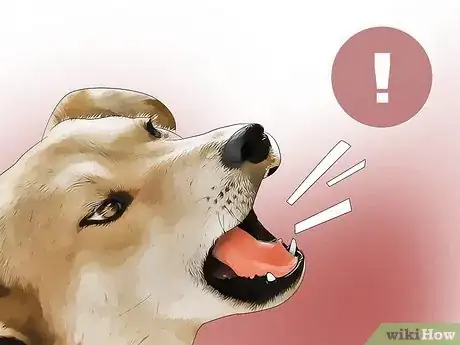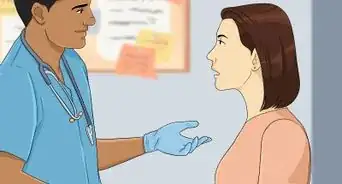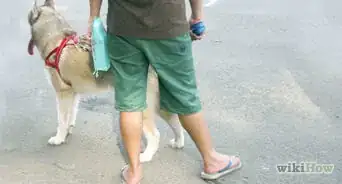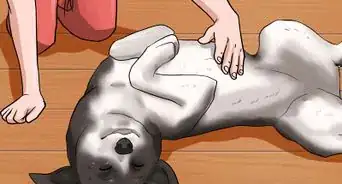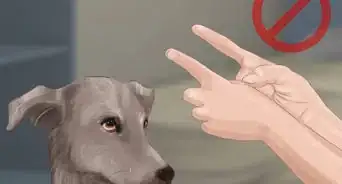This article was co-authored by Belgin Altundag. Belgin Altundag is a Certified Dog Trainer and the Owner of Happy Doggies Day Care/Day Camp in West Hollywood, California. A passionate animal lover, Belgin is knowledgeable about multiple training styles, including obedience training, problem-solving, activity training, and behavior modification. In addition to being an Animal Behavior College’s Certified Dog Trainer (ABCDT), Belgin has also completed the Training Cesar's Way Fundamentals of Dog Behavior and Training Programs 1 and 2 and is certified by the American Red Cross in Cat and Dog First-Aid.
There are 8 references cited in this article, which can be found at the bottom of the page.
This article has been viewed 33,348 times.
Some dogs just don't know when to quit. If you're not very comfortable around them, you can learn more about what kind of behavior to avoid when you see a dog that's acting aggressively. You can also learn what's just a sign of an excited dog. In either case, you can learn how to react calmly and avoid common dog-handling mistakes.
Steps
Reading the Dog
-
1Look at the dog's body language. If you're uncomfortable around dogs, you may take their every move for a sign of danger. Learning a bit about the body language of dogs, though, can help you know when to be cautious.
- Excited signals: Dogs that are panting with their ears up, standing upright, and moving around a lot are probably just excited. While some excited dogs are still nippy, its just happy and wants to play, not to harm you.
- Dangerous signals: Stay clear of a dog that moves slowly, with its ears folded back and its tail is low.[1] If the rear end is higher than the front end and the fur is standing up, or the dog bares its teeth, these are generally signs that the animal is aggressive, feeling threatened, and may attack.
-
2Listen to the dog. Just as you can learn a lot from the body language of a dog, the sounds that a dog makes are indications of its mood and its intentions. Dogs make a variety of sounds that you can learn to interpret, and learn when to be cautious.
- Excited signals: High-pitched barking, squealing, or whining sounds are usually just signs that a dog is worked up. Short bursts of barking may just indicate that the dog wants to play.[2]
- Dangerous signals: When a dog wants to attack, it will be silent. If a dog is feeling threatened, it will growl in as low a pitch as possible and may bark as well.
Advertisement -
3Watch how the dog moves. The way a dog moves toward you or away from you can tell you a lot about its intentions. While any time a dog comes bounding toward you can be somewhat frightening, try to remain calm and learn what to look for.
- Excited signals: Any time a dog is bouncing or jumping around, it's usually just excited, even if it's nipping at you some. If the tail of the dog is wagging and the dog is moving around as if excited, that's probably the case.
- Dangerous signals: Any time a dog gets low and starts slinking as if trying to hide, that's a sign of danger. Dogs do this when they're trying to attack.
-
4Watch for signs of erratic behavior or disease. Dogs that appear to be sick or injured should always be avoided. Even if the dog is friendly, if it's in pain it may be defensive and dangerous. Anytime you see a dog behaving strangely, steer clear. Odd signs to avoid include the following:
- Frothing or foaming at the mouth
- Excessive drooling
- Staggering or walking strangely
- Panting more heavily than normal
- Any bleeding or other obvious signs of injury
-
5Avoid all dogs displaying dangerous aggressive behavior. If you're worried that a dog is more than just excited, the best course of action is always to stay as far away from the animal as possible.[3] While most dogs you'll encounter are likely just over-excited, it's true that some dogs are aggressive in more dangerous ways, and should always be avoided.
- If you can't avoid the dog, such as when you're visiting someone's home, talk to the owner about possibly putting the dog into a separate room, or outside, while you're present. Don't make a big deal of it, just say you're not super-comfortable around dogs.
Reacting Calmly
-
1Turn your back to excited dogs, but not dangerous dogs. If a dog wants to play, you'll quickly be able to give it the impression that you're not interested by turning your back and avoided eye contact with the dog. Most excited dogs will get bored quickly and give up.
- If the dog seems more dangerous than excited, then don't turn your back, which can be a sign of weakness and an invitation to attack. Stay as calm as possible and stay facing the dog, but start moving away slowly.
-
2Move slowly and calmly away from the dog. Take slow and short steps as you move away from the dog, and avoid running in any circumstance. Back away or walk away, looking as if you're not interested or intimidated by the dog.[4] Look like you're doing something else entirely.[5]
- Never run away from dogs. Dogs will often take this as a sign of play and want to chase after you and continue nipping.
-
3Control your breathing. It's true that dogs often sense and react to your emotions. If you're angry, concerned, or excited, dogs will be able to tell. If you're feeling scared, dogs will also be able to tell and might become more anxious in turn, making the situation worse. The best thing you can do is to take deep, slow, even breaths and try to calm down.
- Don't make any noise. If you shout, whimper, or make any submissive sound, the dog will pick up on it and might be encouraged to continue acting aggressively.
- Try to count, if you're feeling really anxious. Take a slow breath for five beats and hold it for two, then let it out for five beats. Keep counting as you move away slowly.
-
4Keep your hands at your sides. Often, dogs will nip at hands, especially if they're feeling excited or aggressive in play. If you stick out your hands to protect yourself, they might be more encouraged to jump up and nip at them.[6]
- Pull your fingers into your coat, if you can, or put them into your pockets if necessary.
-
5Ignore the dog as much as possible.[7] Most dogs will quickly lose interest if you demonstrate that you're not into playing.[8] Move into another room, and avoid looking at the dog as much as possible.[9] If it comes close, ignore it.
- You want to be calm but be assertive. If you move quickly and act scared, the dog will think you are. If you act angry, the dog may react aggressively in turn. The best way to act as if the dog is beneath you, and as if the dog should be submissive to you. If you act this way, the dog will react this way as well.
-
6Let the dog smell you.[10] Most aggressive dogs were abused at one time or another, and are reacting out of fear. If that's the case, you want to let the dog know that you're friendly and you're not going to challenge of abuse the animal. But since you can't talk to the dog, you need to communicate on the dog's terms and let it smell you.
- As the dog approaches, be quiet and be calm, but keep your hands at your sides and control your breathing while it smells. Most dogs should be able to register that you're nice and leave you alone.
-
7Crouch into a defensive posture, if necessary. The crouched position helps you seem less threatening to the dog but also shows him that you are not going to just roll-over on your back and expose your stomach to him. Flex your legs, and get into a football or squatting stance.
- This stance puts you in a maximum position of power because the largest muscles in your body (thigh muscles) are flexed, and your neck is protected, if escape should become necessary.
- Use your other forearm and fist to cover your neck, if necessary. This way, you have offered enough for the dog to acquire your scent, but you have not given up access to any vital areas of your body.
-
8Look for the owner of the dog. If a dog is bothering you, its the owner's responsibility to get it under control as quickly as possible. Don't be afraid to tell the owner of any dog that it's making you uncomfortable and you would like the dog to be restrained.
- If you see a dog on the street without an owner that seems to be aggressive, call animal control immediately and go elsewhere. Write down the street address and take pictures of the animal if possible.
- If the dog belongs to someone and is on a leash, stay out of the range of it. If it's not on a leash, ask the owner to place it on one.
Avoiding Common Mistakes
-
1Don't run away from the dog. Fast movements encourage the dog to react quickly and run along with you. Dogs behave with a pack mentality. If one starts barking, the other will continue barking. If you run, the dog is going to run as well. Make slow, calm movements, and the dog will also calm down.[11]
- Don't make any sorts of fast movements in general, if a dog is being aggressive. No arm swinging, or jumping around. The best way to get it to leave you alone is to ignore it.
-
2Don't make eye contact with aggressive dogs. Dogs are all about status. Eye contact communicates that you're challenging an aggressive alpha dog for dominance.[12] Since you probably have no interest in doing that, it's important to avoid making eye contact with the dog, which can provoke it.[13] [14]
-
3Don't strike an aggressive dog. Striking a dog is never recommended in any circumstance, whether it's being aggressive or not. Dogs learn by positive treatment, like treats and love, not hitting.
-
4Don't shrink into a ball. Some people instinctively want to ball up like a pill-bug if a dog's being nippy or kind of excited and aggressive. This tells the dog that you're submissive and encourages it to continue dominating you. You don't want to collapse into a tiny ball, you want to make yourself appear as big as possible.
- If you're being attacked by a dog, it's important to protect your head and neck as much as possible, and rolling up into a ball may be your safest bet. It's still better to stop moving as much as possible and stay big, however. Read this article for more information about what to do if you're attacked by a dog.
Expert Q&A
Did you know you can get expert answers for this article?
Unlock expert answers by supporting wikiHow
-
QuestionHow can I calm down an aggressive dog?
 Asher SmileyAsher Smiley is the Owner and Lead Instructor at Krav Maga Revolution in Petaluma, California. Asher has earned a Tier 1 Instructor Certification in the American Krav Maga system. In 2017, he trained with the International Kapap Federation Combat Krav Maga International, completing their 7 day tactical seminar and the 8 day CKMI instructor course.
Asher SmileyAsher Smiley is the Owner and Lead Instructor at Krav Maga Revolution in Petaluma, California. Asher has earned a Tier 1 Instructor Certification in the American Krav Maga system. In 2017, he trained with the International Kapap Federation Combat Krav Maga International, completing their 7 day tactical seminar and the 8 day CKMI instructor course.
Self Defense Trainer
-
QuestionHow do I act around an aggressive dog?
 Belgin AltundagBelgin Altundag is a Certified Dog Trainer and the Owner of Happy Doggies Day Care/Day Camp in West Hollywood, California. A passionate animal lover, Belgin is knowledgeable about multiple training styles, including obedience training, problem-solving, activity training, and behavior modification. In addition to being an Animal Behavior College’s Certified Dog Trainer (ABCDT), Belgin has also completed the Training Cesar's Way Fundamentals of Dog Behavior and Training Programs 1 and 2 and is certified by the American Red Cross in Cat and Dog First-Aid.
Belgin AltundagBelgin Altundag is a Certified Dog Trainer and the Owner of Happy Doggies Day Care/Day Camp in West Hollywood, California. A passionate animal lover, Belgin is knowledgeable about multiple training styles, including obedience training, problem-solving, activity training, and behavior modification. In addition to being an Animal Behavior College’s Certified Dog Trainer (ABCDT), Belgin has also completed the Training Cesar's Way Fundamentals of Dog Behavior and Training Programs 1 and 2 and is certified by the American Red Cross in Cat and Dog First-Aid.
Certified Dog Trainer
Warnings
- If the dog has attacked you immediately report to the owner and seek medical attention.⧼thumbs_response⧽
- These steps may not always work and the dog may need to see their animal behaviourist to see if there are any underlying problems.⧼thumbs_response⧽
References
- ↑ https://petcube.com/blog/dog-aggression/#signsofaggressionindogs
- ↑ https://www.hillspet.com/dog-care/play-exercise/dog-aggression-or-playing
- ↑ Asher Smiley. Self Defense Trainer. Expert Interview. 30 July 2019.
- ↑ Belgin Altundag. Certified Dog Trainer. Expert Interview. 26 February 2021
- ↑ https://www.cbsnews.com/news/if-aggressive-dog-threatens-you-know-what-to-do/
- ↑ http://www.pethealthnetwork.com/dog-health/dog-behavior/what-do-if-a-dog-attacks-you
- ↑ https://positively.com/animal-advocacy/dog-bite-prevention/what-to-do-when-a-dog-attacks/
- ↑ Asher Smiley. Self Defense Trainer. Expert Interview. 30 July 2019.
- ↑ Belgin Altundag. Certified Dog Trainer. Expert Interview. 26 February 2021
- ↑ https://www.livescience.com/8525-avoid-attacked-dog.html
- ↑ https://www.livescience.com/8525-avoid-attacked-dog.html
- ↑ Asher Smiley. Self Defense Trainer. Expert Interview. 30 July 2019.
- ↑ Belgin Altundag. Certified Dog Trainer. Expert Interview. 26 February 2021
- ↑ https://www.cbsnews.com/news/if-aggressive-dog-threatens-you-know-what-to-do/




